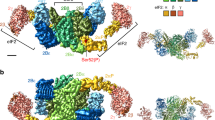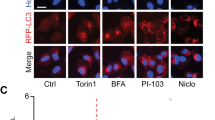Abstract
Eukaryotic translation initiation factor 4B (eIF4B) plays a critical role during the initiation of protein synthesis and its activity can be regulated by multiple phosphorylation events. In a search for novel protein kinase B (PKB/c-akt) substrates, we identified eIF4B as a potential target. Using an in vitro kinase assay, we found that PKB can directly phosphorylate eIF4B on serine 422 (ser422). Activation of a conditional PKB mutant, interleukin-3 (IL-3) or insulin stimulation resulted in PKB-dependent phosphorylation of this residue in vivo. This was prevented by pretreatment of cells with the phosphatidylinositol 3-kinase (PI3K) inhibitor LY294002 or pharmacological inhibition of PKB. Pretreatment of cells with rapamycin, inhibiting mTOR or U0126 to inhibit MEK, had little effect on eIF4B ser422 phosphorylation. In contrast, following amino-acid refeeding, eIF4B ser422 phosphorylation was found to be mammalian target of rapamycin (mTOR)-dependent. We further identified eIF4B ser406 as a novel mitogen-regulated phosphorylation site. Insulin-induced phosphorylation of eIF4B ser406 was dependent on both MEK and mTOR activity. Utilizing a novel translational control luciferase assay, we could further demonstrate that phosphorylation of ser406 or ser422 is essential for optimal translational activity of eIF4B. These data provide novel insights into complex multikinase regulation of eIF4B phosphorylation and reveal an important mechanism by which PKB can regulate translation, potentially critical for the transforming capacity of this AGC kinase family member.
This is a preview of subscription content, access via your institution
Access options
Subscribe to this journal
Receive 50 print issues and online access
$259.00 per year
only $5.18 per issue
Buy this article
- Purchase on Springer Link
- Instant access to full article PDF
Prices may be subject to local taxes which are calculated during checkout







Similar content being viewed by others
References
Burgering BM, Medema RH, Maassen JA, van de Wetering ML, van der Eb AJ, McCormick F et al. (1991). Insulin stimulation of gene expression mediated by p21ras activation. EMBO J 10: 1103–1109.
Calkhoven CF, Muller C, Leutz A . (2000). Translational control of C/EBPalpha and C/EBPbeta isoform expression. Genes Dev 14: 1920–1932.
Dijkers PF, Birkenkamp KU, Lam EW, Thomas NS, Lammers JW, Koenderman L et al. (2002b). FKHR-L1 can act as a critical effector of cell death induced by cytokine withdrawal: protein kinase B-enhanced cell survival through maintenance of mitochondrial integrity. J Cell Biol 156: 531–542.
Dijkers PF, Birkenkamp KU, Lam EW, Thomas NS, Lammers JW, Koenderman L et al. (2002a). FKHR-L1 can act as a critical effector of cell death induced by cytokine withdrawal: protein kinase B-enhanced cell survival through maintenance of mitochondrial integrity. J Cell Biol 156: 531–542.
Duncan R, Hershey JW . (1984). Heat shock-induced translational alterations in HeLa cells. Initiation factor modifications and the inhibition of translation. J Biol Chem 259: 11882–11889.
Duncan R, Hershey JW . (1985). Regulation of initiation factors during translational repression caused by serum depletion. Covalent modification. J Biol Chem 260: 5493–5497.
Gani R . (1976). The nucleoli of cultured human lymphocytes. I nucleolar morphology in relation to transformation and the DNA cycle. Exp Cell Res 97: 249–258.
Garofalo RS, Orena SJ, Rafidi K, Torchia AJ, Stock JL, Hildebrandt AL et al. (2003). Severe diabetes, age-dependent loss of adipose tissue, and mild growth deficiency in mice lacking Akt2/PKB beta. J Clin Invest 112: 197–208.
Gingras AC, Raught B, Sonenberg N . (1999). eIF4 initiation factors: effectors of mRNA recruitment to ribosomes and regulators of translation. Annu Rev Biochem 68: 913–963.
Guertin DA, Sabatini DM . (2005). An expanding role for mTOR in cancer. Trends Mol Med 11: 353–361.
Hershey JW, Merrick WC . (2000). Pathway and mechanism of initiation of protein synthesis. In: Sonenberg N, Hershey JWB, Merrick WC (eds). Translational Control of Gene Expression. Cold Spring Harbor Laboratory Press: Cold Spring Harbor, NY, pp 33–88.
Holland EC, Sonenberg N, Pandolfi PP, Thomas G . (2004b). Signaling control of mRNA translation in cancer pathogenesis. Oncogene 23: 3138–3144.
Holland EC, Sonenberg N, Pandolfi PP, Thomas G . (2004a). Signaling control of mRNA translation in cancer pathogenesis. Oncogene 23: 3138–3144.
Holz MK, Ballif BA, Gygi SP, Blenis J . (2005). mTOR and S6K1 mediate assembly of the translation preinitiation complex through dynamic protein interchange and ordered phosphorylation events. Cell 123: 569–580.
Inoki K, Li Y, Zhu T, Wu J, Guan KL . (2002). TSC2 is phosphorylated and inhibited by Akt and suppresses mTOR signalling. Nat Cell Biol 4: 648–657.
Larsen MR, Thingholm TE, Jensen ON, Roepstorff P, Jorgensen TJ . (2005). Highly selective enrichment of phosphorylated peptides from peptide mixtures using titanium dioxide microcolumns. Mol Cell Proteomics 4: 873–886.
Lawson TG, Lee KA, Maimone MM, Abramson RD, Dever TE, Merrick WC et al. (1989). Dissociation of double-stranded polynucleotide helical structures by eukaryotic initiation factors, as revealed by a novel assay. Biochemistry 28: 4729–4734.
Lodish HF . (1976). Translational control of protein synthesis. Annu Rev Biochem 45: 39–72.
Luo J, Manning BD, Cantley LC . (2003). Targeting the PI3K-Akt pathway in human cancer: rationale and promise. Cancer Cell 4: 257–262.
Mamane Y, Petroulakis E, LeBacquer O, Sonenberg N . (2006). mTOR, translation initiation and cancer. Oncogene 25: 6416–6422.
Methot N, Pause A, Hershey JW, Sonenberg N . (1994). The translation initiation factor eIF-4B contains an RNA-binding region that is distinct and independent from its ribonucleoprotein consensus sequence. Mol Cell Biol 14: 2307–2316.
Methot N, Pickett G, Keene JD, Sonenberg N . (1996a). In vitro RNA selection identifies RNA ligands that specifically bind to eukaryotic translation initiation factor 4B: the role of the RNA remotif. RNA 2: 38–50.
Methot N, Song MS, Sonenberg N . (1996b). A region rich in aspartic acid, arginine, tyrosine, and glycine (DRYG) mediates eukaryotic initiation factor 4B (eIF4B) self-association and interaction with eIF3. Mol Cell Biol 16: 5328–5334.
Naranda T, Strong WB, Menaya J, Fabbri BJ, Hershey JW . (1994). Two structural domains of initiation factor eIF-4B are involved in binding to RNA. J Biol Chem 269: 14465–14472.
Nave BT, Ouwens M, Withers DJ, Alessi DR, Shepherd PR . (1999). Mammalian target of rapamycin is a direct target for protein kinase B: identification of a convergence point for opposing effects of insulin and amino-acid deficiency on protein translation. Biochem J 344 (Pt 2): 427–431.
Nobukuni T, Joaquin M, Roccio M, Dann SG, Kim SY, Gulati P et al. (2005). Amino acids mediate mTOR/raptor signaling through activation of class 3 phosphatidylinositol 3OH-kinase. Proc Natl Acad Sci USA 102: 14238–14243.
Obata T, Yaffe MB, Leparc GG, Piro ET, Maegawa H, Kashiwagi A et al. (2000). Peptide and protein library screening defines optimal substrate motifs for AKT/PKB. J Biol Chem 275: 36108–36115.
Obenauer JC, Cantley LC, Yaffe MB . (2003). Scansite 2.0: Proteome-wide prediction of cell signaling interactions using short sequence motifs. Nucleic Acids Res 31: 3635–3641.
Pandolfi PP . (2004). Aberrant mRNA translation in cancer pathogenesis: an old concept revisited comes finally of age. Oncogene 23: 3134–3137.
Parker PJ, Parkinson SJ . (2001). AGC protein kinase phosphorylation and protein kinase C. Biochem Soc Trans 29: 860–863.
Rajasekhar VK, Viale A, Socci ND, Wiedmann M, Hu X, Holland EC . (2003). Oncogenic Ras and Akt signaling contribute to glioblastoma formation by differential recruitment of existing mRNAs to polysomes. Mol Cell 12: 889–901.
Raught B, Gingras AC, Sonenberg N . (2000). Regulation of ribosomal recruitment in eukaryotes. In: Sonenberg N, Hershey JWB, Merrick WC (eds). Translational Control of Gene Expression. Cold Spring Harbor Laboratory Press: Cold Spring Harbor, NY, pp 245–295.
Raught B, Peiretti F, Gingras AC, Livingstone M, Shahbazian D, Mayeur GL et al. (2004). Phosphorylation of eucaryotic translation initiation factor 4B Ser422 is modulated by S6 kinases. EMBO J 23: 1761–1769.
Richter JD, Sonenberg N . (2005). Regulation of cap-dependent translation by eIF4E inhibitory proteins. Nature 433: 477–480.
Rogers Jr GW, Richter NJ, Lima WF, Merrick WC . (2001). Modulation of the helicase activity of eIF4A by eIF4B, eIF4 H, and eIF4F. J Biol Chem 276: 30914–30922.
Rozen F, Edery I, Meerovitch K, Dever TE, Merrick WC, Sonenberg N . (1990). Bidirectional RNA helicase activity of eucaryotic translation initiation factors 4A and 4F. Mol Cell Biol 10: 1134–1144.
Ruggero D, Montanaro L, Ma L, Xu W, Londei P, Cordon-Cardo C et al. (2004). The translation factor eIF-4E promotes tumor formation and cooperates with c-Myc in lymphomagenesis. Nat Med 10: 484–486.
Ruggero D, Pandolfi PP . (2003). Does the ribosome translate cancer? Nat Rev Cancer 3: 179–192.
Sarbassov DD, Ali SM, Sengupta S, Sheen JH, Hsu PP, Bagley AF et al. (2006). Prolonged rapamycin treatment inhibits mTORC2 assembly and Akt/PKB. Mol Cell 22: 159–168.
Sarbassov DD, Guertin DA, Ali SM, Sabatini DM . (2005). Phosphorylation and regulation of Akt/PKB by the rictor-mTOR complex. Science 307: 1098–1101.
Shahbazian D, Roux PP, Mieulet V, Cohen MS, Raught B, Taunton J et al. (2006). The mTOR/PI3 K and MAPK pathways converge on eIF4B to control its phosphorylation and activity. EMBO J 25: 2781–2791.
van Gorp AG, Pomeranz KM, Birkenkamp KU, Hui RC, Lam EW, Coffer PJ . (2006). Chronic Protein Kinase B (PKB/c-akt) Activation Leads to Apoptosis Induced by Oxidative Stress-Mediated Foxo3a Transcriptional Up-regulation. Cancer Res 66: 10760–10769.
Wiesenthal V, Leutz A, Calkhoven CF . (2006). A translation control reporter system (TCRS) for the analysis of translationally controlled processes in the vertebrate cell. Nucleic Acids Res 34: e23.
Zhang H, Zha X, Tan Y, Hornbeck PV, Mastrangelo AJ, Alessi DR et al. (2002). Phosphoprotein analysis using antibodies broadly reactive against phosphorylated motifs. J Biol Chem 277: 39379–39387.
Acknowledgements
AGM van Gorp and KE van der Vos were supported by a grant from the Dutch Scientific Organization (NWO; ZonMw 917.36.316).
Author information
Authors and Affiliations
Corresponding author
Additional information
Supplementary Information accompanies the paper on the Oncogene website (http://www.nature.com/onc)
Supplementary information
Rights and permissions
About this article
Cite this article
van Gorp, A., van der Vos, K., Brenkman, A. et al. AGC kinases regulate phosphorylation and activation of eukaryotic translation initiation factor 4B. Oncogene 28, 95–106 (2009). https://doi.org/10.1038/onc.2008.367
Received:
Revised:
Accepted:
Published:
Issue Date:
DOI: https://doi.org/10.1038/onc.2008.367
Keywords
This article is cited by
-
OTS167 blocks FLT3 translation and synergizes with FLT3 inhibitors in FLT3 mutant acute myeloid leukemia
Blood Cancer Journal (2021)
-
A novel path-specific effect statistic for identifying the differential specific paths in systems epidemiology
BMC Genetics (2020)
-
eIF4B and eIF4H mediate GR production from expanded G4C2 in a Drosophila model for C9orf72-associated ALS
Acta Neuropathologica Communications (2019)
-
Reduced menin expression impairs rapamycin effects as evidenced by an increase in mTORC2 signaling and cell migration
Cell Communication and Signaling (2018)
-
eIF4B phosphorylation at Ser504 links synaptic activity with protein translation in physiology and pathology
Scientific Reports (2017)



